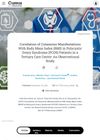TLDR Most women with polycystic ovary syndrome (PCOS) have menstrual issues, infertility, acne, and excessive body hair, with the most common type being the non-androgenic phenotype.
The study involved 34 women with polycystic ovary syndrome (PCOS) and 30 healthy women. It was found that 73.5% of the women with PCOS had menstrual cycle disorders, 52.9% had infertility, and 47.1% had acne, while 41.2% had hirsutism. Hyperandrogenism was present in 55.9% of the women with PCOS, indicated by higher levels of androstenedione and free testosterone. The most common clinical variant of PCOS was the non-androgenic phenotype (phenotype D), found in 44.1% of the women. The classic (phenotype A) and incomplete classic (phenotype B) were found in 32.4% and 14.7% of women respectively, and only 8.8% had the ovulatory phenotype (phenotype C).
 2 citations
,
January 2018 in “Sovremennye problemy nauki i obrazovaniâ”
2 citations
,
January 2018 in “Sovremennye problemy nauki i obrazovaniâ” Hirsutism and acanthosis nigricans are important for diagnosing PCOS; dermatologists play a key role in early detection and treatment.
 1265 citations
,
October 2013 in “The Journal of Clinical Endocrinology and Metabolism”
1265 citations
,
October 2013 in “The Journal of Clinical Endocrinology and Metabolism” The guideline suggests using specific criteria to diagnose PCOS, recommends various treatments for its symptoms, and advises screening for related health issues.
 4025 citations
,
December 2003 in “Human Reproduction”
4025 citations
,
December 2003 in “Human Reproduction” The 2003 consensus updated PCOS diagnosis criteria and linked PCOS to higher risks of diabetes and heart problems, recommending lifestyle changes to lower these risks.
 1 citations
,
December 2021 in “Cureus”
1 citations
,
December 2021 in “Cureus” Overweight PCOS patients often have skin issues like acne, but all PCOS patients should get lifestyle advice.
 17 citations
,
September 2017 in “Journal of Cosmetic Dermatology”
17 citations
,
September 2017 in “Journal of Cosmetic Dermatology” Women with PCOS in North China often have hirsutism and acne, with hirsutism linked to metabolic issues.
 5 citations
,
June 2010 in “Endocrinología y Nutrición”
5 citations
,
June 2010 in “Endocrinología y Nutrición” Diagnosing and managing PCOS in teens is hard, but early diagnosis and lifestyle changes are key, and more research is needed for long-term health.






